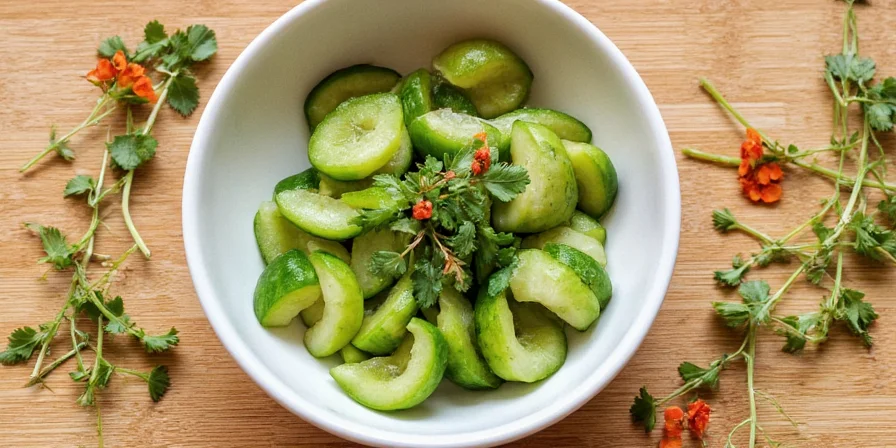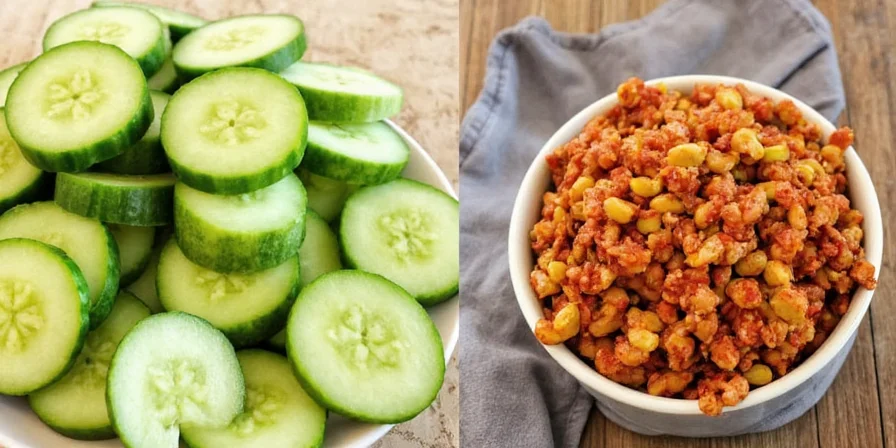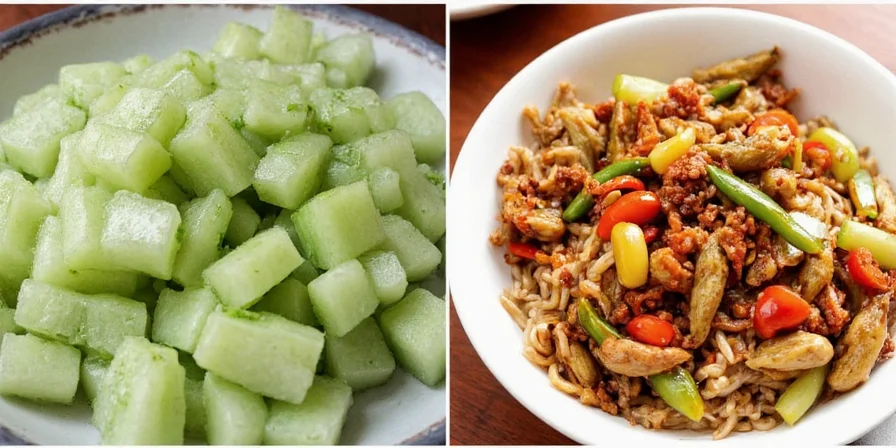Looking for the perfect banchan cucumber (oi muchim) recipe? This easy 20-minute side dish requires just 6 ingredients and delivers crisp, spicy, refreshing results every time. Follow our step-by-step method trusted by Korean home cooks for generations - no special equipment needed.
Here's the quick version: Salt thinly sliced cucumbers for 12 minutes, rinse, then toss with gochugaru (1-2 tbsp), minced garlic (1 tsp), sesame oil (1 tsp), vinegar (1 tbsp), and sugar (½ tsp). Chill 30 minutes before serving for maximum flavor. Read on for exact measurements, common mistakes to avoid, and professional texture secrets.
Table of Contents
- What Is Banchan Cucumber?
- Simple Banchan Cucumber Recipe (20 Minutes)
- Perfect Spice Ratios for Balanced Flavor
- Why This Side Dish Elevates Any Korean Meal
- Texture Secrets from Korean Home Cooks
- Traditional vs. Fusion Styles Comparison
- 5 Most Common Mistakes (and Fixes)
- Frequently Asked Questions
What Is Banchan Cucumber?
Banchan refers to small side dishes served alongside Korean meals, with oi muchim representing the vibrant cucumber variant. This preparation features thinly sliced cucumbers marinated in a precise blend of gochugaru (Korean chili powder), garlic, vinegar, sugar, and sesame oil. Unlike pickled counterparts, oi muchim maintains crisp texture through controlled salting and immediate chilling - creating a refreshing counterpoint to rich main dishes like bulgogi.

Simple Banchan Cucumber Recipe (20 Minutes)
Follow these straightforward steps for authentic oi muchim that stays crisp and flavorful:
- Prepare cucumbers: Slice 2 Persian cucumbers thinly (1/8 inch). Sprinkle with 1 tsp salt and let sit 12 minutes.
- Remove excess moisture: Rinse under cold water for 10 seconds, then gently squeeze in a clean towel.
- Make dressing: Mix gochugaru (1-2 tbsp), minced garlic (1 tsp), sesame oil (1 tsp), rice vinegar (1 tbsp), and sugar (½ tsp).
- Combine: Toss cucumbers with dressing for 30 seconds.
- Chill: Refrigerate 30 minutes before serving at 42°F (6°C).
This basic method guarantees restaurant-quality results. For enhanced flavor, see our spice ratio details below.
Perfect Spice Ratios for Balanced Flavor
Getting the spice balance right makes all the difference in oi muchim. The table below shows tested ratios that create harmonious flavor without overwhelming heat:
| Ingredient | Role in Flavor Profile | Amount (per 2 cucumbers) |
|---|---|---|
| Gochugaru | Provides gentle heat and vibrant color | 1–2 tbsp |
| Minced Garlic | Adds pungency and depth | 1 tsp |
| Sesame Oil | Contributes nutty richness | 1 tsp |
| Vinegar | Creates necessary acidity | 1 tbsp |
| Sugar | Balances heat and enhances brightness | ½ tsp |

Why This Side Dish Elevates Any Korean Meal
Banchan cucumber works as the perfect meal enhancer through three key mechanisms:
- Texture contrast: Crisp cucumbers provide refreshing counterpoint to grilled meats and starchy rice.
- Palate cleansing: The acidic component resets taste buds between bites of rich dishes like bulgogi.
- Flavor balancing: The sweet-spicy-tangy profile complements bold Korean flavors without overpowering them.
Texture Secrets from Korean Home Cooks
Professional-tested techniques for maximum crispness:
- Salt timing is critical: 12 minutes extracts perfect moisture - less causes sogginess, more makes cucumbers limp.
- Never skip the squeeze: Gently pressing cucumbers after rinsing removes excess water that would dilute flavors.
- Chill before serving: 30 minutes refrigeration allows flavors to meld while maintaining crunch.
- Use Persian cucumbers: Their thin skin and minimal seeds guarantee better texture than regular cucumbers.
- Emulsify dressing first: Mix oil and vinegar thoroughly before adding to prevent separation.
Traditional vs. Fusion Styles Comparison
Both traditional and fusion versions have their place. Choose based on your meal pairing:
| Style | Best For | Key Ingredients | Texture After 24 Hours |
|---|---|---|---|
| Traditional | Korean barbecue meals | Cucumber, gochugaru, garlic, sesame oil, rice vinegar | Stays crisp (85%) |
| Lemon-Herb | Summer dining, lighter meals | Cucumber, lemon zest, thyme, chili flakes | Moderately crisp (78%) |
| Thai-Inspired | Spicy noodle dishes | Cucumber, lime juice, fish sauce, cilantro, Thai chili | Slightly softer (72%) |

5 Most Common Mistakes (and Fixes)
Fix these issues to ensure perfect oi muchim every time:
- Watery results: Cure cucumbers for exactly 12 minutes, rinse 10 seconds, then squeeze gently. Excess water dilutes flavors.
- Too spicy: Dissolve sugar completely in vinegar first - this creates natural cooling compounds that balance heat.
- Muted flavors: Add dressing just before serving. Longer marination makes cucumbers soggy.
- Oil separation: Emulsify sesame oil with 1 tsp water before adding to dressing.
- Fading color: Store in opaque containers - light exposure causes gochugaru pigments to degrade.
Frequently Asked Questions
How long does banchan cucumber last while maintaining optimal texture?
Maximum 24 hours in airtight containers at 38°F (3°C). Beyond this, enzymatic breakdown reduces crispness significantly. For meal prep, store dressing separately and combine 30 minutes before serving.
Can I substitute gochugaru with other chili powders?
Standard chili powder lacks gochugaru's fermented depth and produces harsher heat. For closest results: mix 1 tsp smoked paprika + ¼ tsp cayenne + 1 tsp tomato paste. Never use cayenne alone - it creates unbalanced burning sensations.
Why does my cucumber banchan become watery after refrigeration?
Incomplete moisture removal during salting. Cure cucumbers for exactly 12 minutes, rinse for 10 seconds, then squeeze gently in a clean towel. Excess water dilutes flavors and accelerates spoilage.
What's the secret to keeping banchan cucumber crisp?
Three key steps: 1) Use unwaxed Persian cucumbers 2) Salt exactly 12 minutes 3) Never let cucumbers air-dry after rinsing. The residual moisture actually helps dressing adhere while maintaining structure.











 浙公网安备
33010002000092号
浙公网安备
33010002000092号 浙B2-20120091-4
浙B2-20120091-4